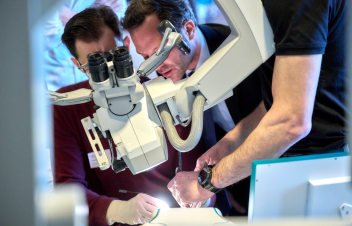Aneurysm Clipping Simulation: A Game-Changer for Complex Brain Surgery Training
- surgeonslab1
- Dec 6, 2024
- 4 min read

Training for complex neurosurgery is vital. It's crucial with life-threatening issues like brain aneurysms. Aneurysm clipping is one of the most delicate and complicated surgical techniques demanding a highly precise and high-level professional. In such a setting, Aneurysm Clipping Simulation works as a great transformative power that brings an entirely new dimension to the training and education process in surgery. New tech is transforming how neurosurgeons learn. Virtual reality and surgical simulations are making brain surgery training easier and more effective than ever.
The Rise of Aneurysm Clipping Simulation
Aneurysm clipping simulation is a modern technology for simulation in virtual reality and complicated surgical software, generating an especially realistic training. This rather new approach has been of great interest to medicine, because it provides safety and can be used in active training practices for complex operations on brain structures.
Some of the current technologies found in this field are SurgeonsLab, which was the world's first virtual reality simulation software for surgical neuroeducation. SurgeonsLab offers all the modules for neurosurgical procedures, like Aneurysm Clipping Simulation, allowing trainees to be instructed in the many neurosurgical maneuvers with no harm or hazard.
Aneurysm Clipping Simulation is one of the most realistically interactive modules found in SurgeonsLab. It allows students to navigate through a virtual brain to identify aneurysms and practice the very delicate clipping procedure. Real-time feedback is provided to surgeons during practice to enhance the skill and technique. The fully interactive training environment has been significantly improved in neurosurgical education.
Benefits of Aneurysm Clipping Simulation
Realistic and Interactive Training
The aneurysm clipping simulation also depicts the highly realistic brain anatomy that lets the students interact directly with virtual tissues and vessels. Trainees practice clipping and can manipulate instruments that have the desired interaction; then, at the immediate end, they learn how they have performed in reality. This form of interaction indeed makes the learning of something of significantly higher interest and efficacy.
Risk-Free Practice Environment
The greatest advantage of Aneurysm Clipping Simulation is that it provides a risk-free training environment. Surgeons can make mistakes and learn from them without causing any harm to the patients. This is especially important for complex procedures such as aneurysm clipping, where even minor errors may lead to grave consequences. The simulation allows trainees to hone their skills, build confidence, and reduce the learning curve before working with real patients.
Customizable Scenarios and Patient Cases
SurgeonsLab and other Aneurysm Clipping Simulation sites offer the wide-ranging scenarios and patient cases. Therefore, trainees would practice all types, locations, and complexities of aneurysms so they will be better prepared to encounter a multitude of challenges during surgeries. Adaptability would thus ensure that surgeons were more poised to address a wide clinical situation to improve care of the patients.
Objective Performance Assessment
It will also enable the performance to be well-monitored, together with informative feedback that lets the trainee appraise himself or herself in objectivity. Data-centric in this case allows one to zero down on weak points to work on them. Thus, with progress tracking, a surgeon gets his technique perfect and capable enough for presentation in the operation theater.
Cost-Effective and Accessible Training
Traditional methods of training like cadaveric dissections are very expensive and logistically cumbersome. The Aneurysm Clipping Simulation, however, is very cheap since it does not use physical specimens and requires no special facilities. One can access the software remotely and, therefore, be accessible to trainees worldwide regardless of their location. Such accessibility is very advantageous for medical institutions and surgeons operating in remote locations.
Endovascular Training and Aneurysm Coiling Simulation
While Aneurysm Clipping Simulation is focused on open surgery, another very important aspect of neurosurgical training is endovascular training. For aneurysm, coiling is one kind of endovascular treatment using catheters and micro-instruments to treat an aneurysm inside the blood vessels.
SurgeonsLab, along with other simulation technologies, offers Endovascular Training modules in which the trainee is given the opportunity to develop catheter navigation, coil deployment, and all other endovascular techniques. Approach in itself is rather exhaustive by nature, hence neurosurgeons become good on both open and endovascular procedures.
The Future of Neurosurgical Training
This innovation regarding Aneurysm Clipping Simulation and Endovascular Training is critical to the achievement of elevated safety and better surgical outcomes. More dramatically advancing with technology, we look forward to seeing a further revolution in surgical simulation in all directions, especially with an increased sense of reality to haptic feedback and in incorporating augmented reality (AR). This paper uses leading-edge advancements in surgical simulation technology in the skyscraper technique to show the benefits of Aneurysm Clipping Simulation and give a summary of its effects on neurosurgical training. This paper is an attempt to provide the reference work that medical professionals will need to provide information about Aneurysm Clipping Simulation and its role in training for advanced brain surgery.
To Summarize
Aneurysm Clipping Simulation is a revolutionary breakthrough in neurosurgical education. It is a secure, lifelike, and easily accessible tool for preparing neurosurgeons for complex brain surgery. The most recent VR technology and platforms, such as SurgeonsLab, support neurosurgeons in developing their skills, avoiding risk, and, consequently, delivering better patient care. Further advances in surgical simulation are to be expected as this area continues to evolve; in fact, they are expected to revolutionize the way neurosurgical education will continue in the future and improve patient results.







